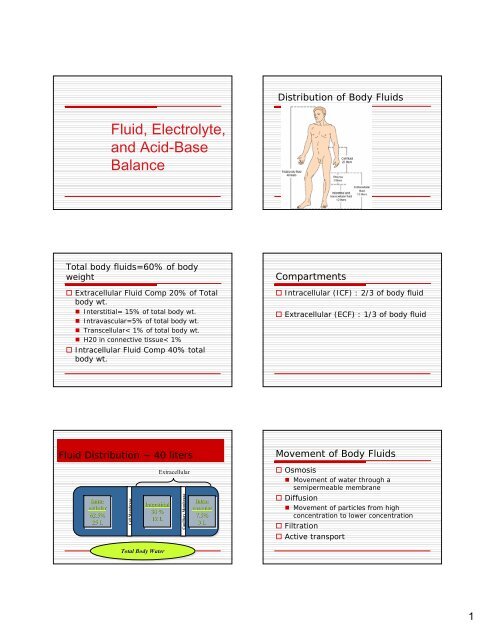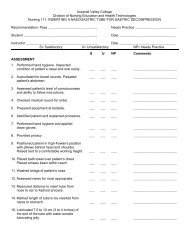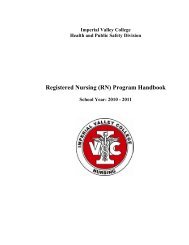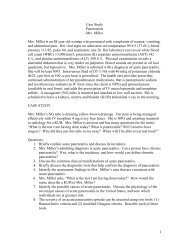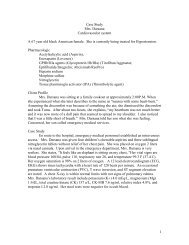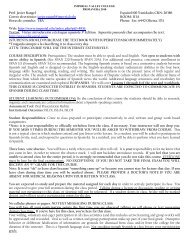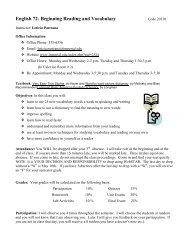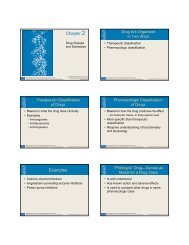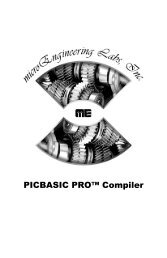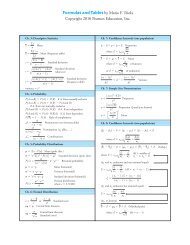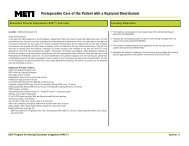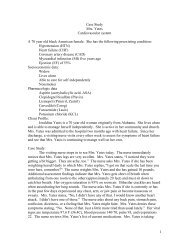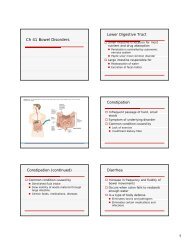Fluid, Electrolyte, and Acid-Base Balance
Fluid, Electrolyte, and Acid-Base Balance
Fluid, Electrolyte, and Acid-Base Balance
Create successful ePaper yourself
Turn your PDF publications into a flip-book with our unique Google optimized e-Paper software.
Figure 52-8Antidiuretic hormone (ADH) regulates water excretion from the kidneys.Aldosterone(stimulated by thefollowing) Inc. K+ Decreased Na+ Decreased blood vol. Decreased C.O. Decreased arterial BPTriggers the Renin angio ald. System ^Absorption of Na+ ^Abs. H20 ^excretion of K+ ^excretion of H ionsGlucocorticoids Released when body is stressed• Promote renal retention of sodium <strong>and</strong>waterAtrial natriuretic peptide (ANP) Causes vasodilation Suppression of renin-angiotensinsystem Decreases ADH release by pituitarygl<strong>and</strong> causing increased urinaryexcretion of water Increases glomerular filtration ratesinc urine production.Brain natriuretic peptide (BNP) Stretch of cardiac ventricles BNP released• Vasodilates arteries <strong>and</strong> veins• Decreased release of aldosterone• Causes diuresis with excretion of bothsodium <strong>and</strong> waterRegulating <strong>Electrolyte</strong>s Sodium 135-145 mEq/L Potassium 3.5-5.0 mEq/L Calcium (total) 4.5-5.5mEq/L or 8.5-10.5mg/dL Calcium (ionized) 56% of total calcium(2.5mEq/L or 4.0-5.0mg/dL) Magnesium 1.5-2.5mEq/L or 1.6-2.5mg/dL Chloride 95-108mEq/L Phosphate 1.8-2.6mEq/L or 2.5-4.5mg/dL Bicarbonate 22-26mEq/L5
<strong>Fluid</strong> Volume Deficit Isotonic <strong>Fluid</strong> loss Hypertonic Dehyration Third spacing<strong>Fluid</strong> Imbalances Isotonic loss of water <strong>and</strong> electrolytes(fluid volume deficit) Isotonic gain of water <strong>and</strong>electrolytes (fluid volume excess) Hyperosmolar loss of only water(dehydration) Hypo-osmolar gain of only water(overhydration)Urine Specific Gravity Urine 1.010-1.030Regulation <strong>Acid</strong>-<strong>Base</strong> <strong>Balance</strong>Regulation of <strong>Acid</strong>-<strong>Base</strong><strong>Balance</strong> Low pH = acidic High pH = alkalinic Body fluids maintained between pH of7.35 <strong>and</strong> 7.45 by• Buffers• Respiratory system• Renal system6
Buffers Prevent excessivechanges in pH Major buffer in ECFis HCO 3<strong>and</strong> H 2CO 3 Other buffersinclude:• Plasma proteins• Hemoglobin• PhosphatesLungs Regulate acid-base balance byeliminating or retaining carbondioxide Does this by altering rate/depth ofrespirations• Faster rate/more depth = get rid of moreCO 2<strong>and</strong> pH rises• Slower rate/less depth = retain CO 2<strong>and</strong>pH lowersKidneys Regulate by selectively excreting orconserving bicarbonate <strong>and</strong> hydrogenions Slower to respond to changeFactors Affecting Body <strong>Fluid</strong>,<strong>Electrolyte</strong>, <strong>and</strong> <strong>Acid</strong>-<strong>Base</strong> <strong>Balance</strong> Age Gender Body size Environmental temperature LifestyleRisk Factors for <strong>Fluid</strong>, <strong>Electrolyte</strong>,<strong>and</strong> <strong>Acid</strong>-<strong>Base</strong> Imbalances<strong>Electrolyte</strong> Imbalances Chronic diseases Acute conditions Medications Treatments Extremes of age Inability to access food <strong>and</strong> fluids Hyponatremia Hypernatremia Hypokalemia Hyperkalemia Hypocalcemia Hypercalcemia Hypomagnesemia Hypermagnesemia Hypochloremia Hyperchloremia Hypophosphatemia Hyperphosphatemia7
<strong>Acid</strong>-<strong>Base</strong> Imbalances Respiratory acidosis Respiratory alkalosis Metabolic acidosis Metabolic alkalosisCollecting Assessment Data Nursing history Physical assessment Clinical measurement Review of laboratory test results Evaluation of edemaEvaluation of EdemaDiagram of Serum<strong>Electrolyte</strong> ResultsNANDA Nursing Diagnoses Deficient <strong>Fluid</strong> Volume Excess <strong>Fluid</strong> Volume Risk for Imbalanced <strong>Fluid</strong> Volume Risk for Deficient <strong>Fluid</strong> volume Impaired Gas ExchangeNANDA Nursing Diagnoses <strong>Fluid</strong> <strong>and</strong> <strong>Acid</strong>-base Imbalances asEtiology• Impaired Oral Mucous Membrane• Impaired Skin Integrity• Decreased Cardiac Output• Ineffective Tissue Perfusion• Activity Intolerance• Risk for Injury• Acute Confusion8
Desired Outcomes Maintain or restore normal fluidbalance Maintain or restore normal balance ofelectrolytes Maintain or restore pulmonaryventilation <strong>and</strong> oxygenation Prevent associated risks• Tissue breakdown, decreased cardiacoutput, confusion, other neurologic signsNursing Interventions Monitoring• <strong>Fluid</strong> intake <strong>and</strong> output• Cardiovascular <strong>and</strong> respiratory status• Results of laboratory tests Assessing• Client’s weight• Location <strong>and</strong> extent of edema, if present• Skin turgor <strong>and</strong> skin status• Specific gravity of urine• Level of consciousness, <strong>and</strong> mental statusNursing Interventions <strong>Fluid</strong> intake modifications Dietary changes Parenteral fluid, electrolyte, <strong>and</strong> bloodreplacement Other appropriate measures such as:• Administering prescribed medications <strong>and</strong>oxygen• Providing skin care <strong>and</strong> oral hygiene• Positioning the client appropriately• Scheduling rest periodsPromoting <strong>Fluid</strong> <strong>and</strong><strong>Electrolyte</strong> <strong>Balance</strong> Consume 6-8 glasses water daily Avoid foods with excess salt, sugar,caffeine Eat well-balanced diet Limit alcohol intake Increase fluid intake before, during,after strenuous exercise Replace lost electrolytesPromoting <strong>Fluid</strong> <strong>and</strong><strong>Electrolyte</strong> <strong>Balance</strong> Maintain normal body weight Learn about, monitor, manage sideeffects of medications Recognize risk factors Seek professional health care fornotable signs of fluid imbalancesTeaching Client to Maintain<strong>Fluid</strong> <strong>and</strong> <strong>Electrolyte</strong> <strong>Balance</strong> Promoting fluid <strong>and</strong> electrolyte balance Monitoring fluid intake <strong>and</strong> output Maintaining food <strong>and</strong> fluid intake Safety Medications Measures specific to client’s problems Referrals Community agencies <strong>and</strong> other sources ofhelp Facilitating fluid intake9
Practice GuidelinesFacilitating <strong>Fluid</strong> IntakePractice GuidelinesRestricting <strong>Fluid</strong> IntakeExplain reason for required intake <strong>and</strong> amount neededEstablish 24 hour plan for ingesting fluidsSet short term goalsIdentify fluids client likes <strong>and</strong> use thoseHelp clients select foods that become liquid at roomtemperatureSupply cups, glasses, strawsServe fluids at proper temperatureEncourage participation in recording intakeBe alert to cultural implications Explain reason <strong>and</strong> amount of restriction Help client establish ingestion schedule Identify preferences <strong>and</strong> obtain Set short term goals; place fluids in smallcontainers Offer ice chips <strong>and</strong> mouth care Teach avoidance of ingesting chewy, salty,sweet foods or fluids Encourage participation in recording intakeCorrecting Imbalances Oral replacement• If client is not vomiting• If client has not experienced excessivefluid loss• Has intact GI tract <strong>and</strong> gag <strong>and</strong> swallowreflexesCorrecting Imbalances Restricted fluids may be necessary forfluid retention• Vary from nothing by mouth to preciseamount ordered• Dietary changesOral Supplements Potassium Calcium Multivitamins Sports drinkEvaluation Collect data as identified in the planof care If desired outcomes are not achieved,explore the reasons before modifyingthe care plan10
Question 1An elderly nursing home resident has refused toeat or drink for several days <strong>and</strong> is admitted tothe hospital. The nurse should assess for whichof the following?1. Increased blood pressure2. Weak, rapid pulse3. Moist mucous membranes4. Jugular vein distentionRationales 11. This option is indicative of fluidvolume excess.2. Correct. A client that has not eatenor drank anything for several dayswould be experiencing fluid volumedeficit.3. This option is indicative of fluidvolume excess.4. This option is indicative of fluidvolume excess.Question 2A man brings his elderly wife to theemergency department. He states that shehas been vomiting <strong>and</strong> has had diarrheafor the past 2 days. She appears lethargic<strong>and</strong> is complaining of leg cramps. Whatshould the nurse do first?1. Start an IV.2. Review the results of serum electrolytes.3. Offer the woman foods that are high in sodium<strong>and</strong> potassium content.4. Administer an antiemetic.Rationales 21. While the nurse may perform thisintervention, assessment is neededinitially.2. Correct.: Further assessment isneeded to determine appropriateaction.3. While the nurse may this intervention,assessment is needed initially.4. While the nurse may this intervention,assessment is needed initially.Question 3Which of the following client statementsindicates a need for further teachingregarding treatment for hypokalemia?1. “I will use avocado in my salads.”2. “I will be sure to check my heart rate before Itake my digoxin.”3. “I will take my potassium in the morning aftereating breakfast.”4. “I will stop using my salt substitute.”Rationales 31. Avocado is higher in potassium than mostfoods.2. Hypokalemia can potentiate digoxintoxicity <strong>and</strong> checking the pulse will helpthe client to avoid this.3. It is important to take potassium with foodto avoid gastric upset.4. Correct. Salt substitutes containpotassium. The client can still use it withinreason.11
Question 4An elderly man is admitted to the medicalunit with a diagnosis of dehydration. Whichof the following signs or symptoms aremost representative of a sodiumimbalance?1. Hyperreflexia2. Mental confusion3. Irregular pulse4. Muscle weaknessRationales 41. Because calcium contributes to thefunction of voluntary muscle contraction,this option is more appropriate for calciumimbalances.2. Correct. Sodium contributes to thefunction of neural tissue.3. Because potassium <strong>and</strong> calcium contributeto cardiac function, irregular pulse is morelikely to be associated with thosealterations.4. Because calcium contributes to thefunction of voluntary muscle contraction,this option is more appropriate for calciumimbalances.Question 5A client is admitted to the hospitalfor hypocalcemia. Nursinginterventions relating to whichsystem would have the highestpriority?1. Renal2. Cardiac3. Gastrointestinal4. NeuromuscularRationales 51. Incorrect.2. Incorrect.3. Incorrect.4. Correct. The major clinical signs <strong>and</strong>symptoms of hypocalcemia are dueto increased neuromuscular activity.12


